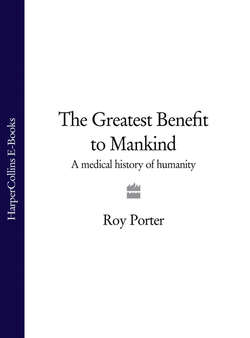Читать книгу The Greatest Benefit to Mankind: A Medical History of Humanity - Roy Porter - Страница 15
MAKING SENSE OF SICKNESS
ОглавлениеThough prehistoric hunting and gathering groups largely escaped epidemics, individuals got sick. Comparison with similar groups today, for instance the Kalahari bush people, suggests they would have managed their health collectively, without experts. A case of illness or debility directly affected the well-being of the band: a sick or lame person is a serious handicap to a group on the move; hence healing rituals or treatment would be a public matter rather than (as Western medicine has come to see them) private.
Anthropologists sometimes posit two contrasting ‘sick roles’: one in which the sick person is treated as a child, fed and protected during illness or incapacity; the other in which the sufferer either leaves the group or is abandoned or, as with lepers in medieval Europe, ritually expelled, becoming culturally ‘dead’ before they are biologically dead. Hunter-gatherer bands were more likely to abandon their sick than to succour them.
With population rise, agriculture, and the emergence of epidemics, new medical beliefs and practices arose, reflecting growing economic, political and social complexities. Communities developed hierarchical systems, identified by wealth, power and prestige. With an emergent division of labour, medical expertise became the métier of particular individuals. Although the family remained the first line of defence against illness, it was bolstered by medicine men, diviners, witch-smellers and shamans, and in due course by herbalists, birth-attendants, bone-setters, barber-surgeons and healer-priests. When that first happened we cannot be sure. Cave paintings found in France, some 17,000 years old, contain images of men masked in animal heads, performing ritual dances; these may be the oldest surviving images of medicine-men.
Highly distinctive was the shaman. On first encountering such folk healers, westerners denounced them as impostors. In 1763 the Scottish surgeon John Bell (1691–1780) described the ‘charming sessions’ he witnessed in southern Siberia:
[the shaman] turned and distorted his body into many different postures, till, at last, he wrought himself up to such a degree of fury that he foamed at the mouth, and his eyes looked red and staring. He now started up on his legs, and fell a dancing, like one distracted, till he trod out the fire with his bare feet.
These unnatural motions were, by the vulgar, attributed to the operations of a divinity … He now performed several legerdemain tricks; such as stabbing himself with a knife, and bringing it up at his mouth, running himself through with a sword and many others too trifling to mention.
This Calvinist Scot was not going to be taken in by Asiatic savages: ‘nothing is more evident than that these shamans are a parcel of jugglers, who impose on the ignorant and credulous vulgar.’ Such a reaction is arrogantly ethnocentric: although shamans perform magical acts, including deliberate deceptions, they are neither fakes nor mad. Common in native American culture as well as Asia, the shaman combined the roles of healer, sorcerer, seer, educator and priest, and was believed to possess god-given powers to heal the sick and to ensure fertility, a good harvest or a successful hunt. His main healing techniques have been categorized as contagious magic (destruction of enemies, through such means as the use of effigies) and direct magic, involving rituals to prevent disease, fetishes, amulets (to protect against black magic), and talismans (for good luck).
In 1912 Sir Baldwin Spencer (1860–1929) and F.J. Gillen (1856–1912) described the practices of the aborigine medicine-man in Central Australia:
In ordinary cases the patient lies down, while the medicine man bends over him and sucks vigorously at the part of the body affected, spitting out every now and then pieces of wood, bone or stone, the presence of which is believed to be causing the injury and pain. This suction is one of the most characteristic features of native medical treatment, as pain in any part of the body is always attributed to the presence of some foreign body that must be removed.
Stone-sucking is a symbolic act. As the foreign body had been introduced into the body of the sick man by a magical route, it had to be removed in like manner. For the medicine-man, the foreign body in his mouth attracts the foreign body in the patient.
As such specialist healers emerged, and as labour power grew more valuable in structured agricultural and commercial societies, the appropriate ‘sick role’ shifted from abandonment to one modelled on child care. The exhausting physical labour required of farm workers encouraged medicines that would give strength; hence, together with drugs to relieve fevers, dysentery and pain, demand grew for stimulants and tonics such as tobacco, coca, opium and alcohol.
In hierarchical societies like Assyria or the Egypt of the pharaohs, with their military – political elites, illness became unequally distributed and thus the subject of moral, religious and political teachings and judgments. Its meanings needed to be explained. Social stratification meanwhile offered fresh scope for enterprising healers; demand for medicines grew; social development created new forms of healing as well as of faith, ritual and worship; sickness needed to be rationalized and theorized. In short, with settlement and literacy, conditions were ripe for the development of medicine as a belief-system and an occupation.
